engine FIAT IDEA 2009 1.G Owner's Manual
[x] Cancel search | Manufacturer: FIAT, Model Year: 2009, Model line: IDEA, Model: FIAT IDEA 2009 1.GPages: 210, PDF Size: 3.62 MB
Page 88 of 210
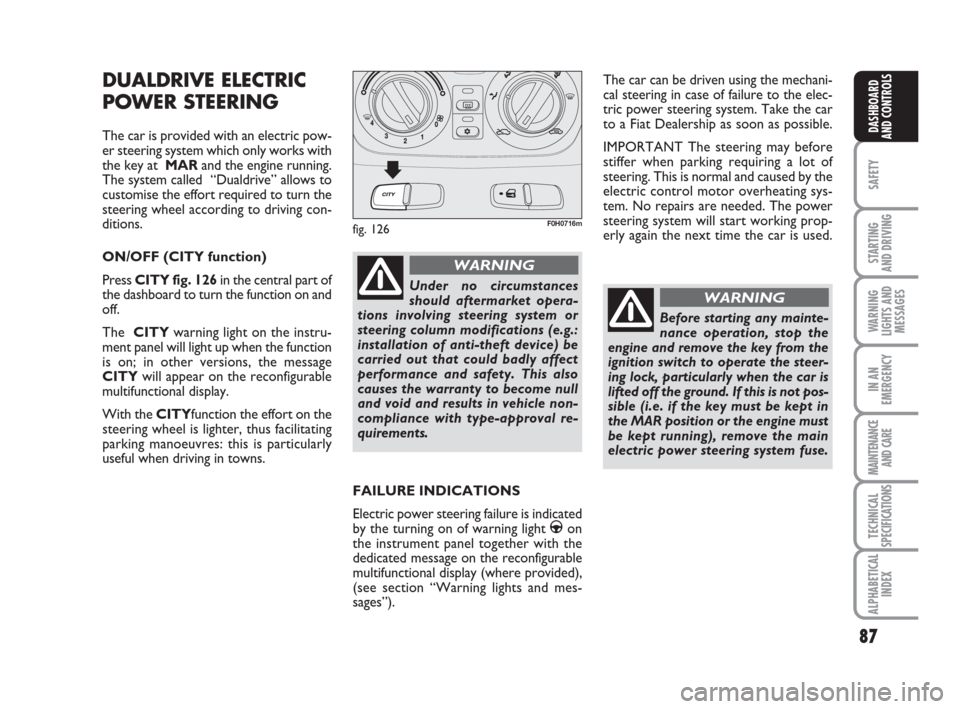
87
SAFETY
STARTING
AND DRIVING
WARNING
LIGHTS AND
MESSAGES
IN AN
EMERGENCY
MAINTENANCE
AND CARE
TECHNICAL
SPECIFICATIONS
ALPHABETICAL
INDEX
DASHBOARD
AND CONTROLS
DUALDRIVE ELECTRIC
POWER STEERING
The car is provided with an electric pow-
er steering system which only works with
the key at MARand the engine running.
The system called “Dualdrive” allows to
customise the effort required to turn the
steering wheel according to driving con-
ditions.
ON/OFF (CITY function)
Press CITY fig. 126in the central part of
the dashboard to turn the function on and
off.
The CITYwarning light on the instru-
ment panel will light up when the function
is on; in other versions, the message
CITYwill appear on the reconfigurable
multifunctional display.
With the CITYfunction the effort on the
steering wheel is lighter, thus facilitating
parking manoeuvres: this is particularly
useful when driving in towns.
fig. 126F0H0716m
Under no circumstances
should aftermarket opera-
tions involving steering system or
steering column modifications (e.g.:
installation of anti-theft device) be
carried out that could badly affect
performance and safety. This also
causes the warranty to become null
and void and results in vehicle non-
compliance with type-approval re-
quirements.
WARNING
The car can be driven using the mechani-
cal steering in case of failure to the elec-
tric power steering system. Take the car
to a Fiat Dealership as soon as possible.
IMPORTANT The steering may before
stiffer when parking requiring a lot of
steering. This is normal and caused by the
electric control motor overheating sys-
tem. No repairs are needed. The power
steering system will start working prop-
erly again the next time the car is used.
Before starting any mainte-
nance operation, stop the
engine and remove the key from the
ignition switch to operate the steer-
ing lock, particularly when the car is
lifted off the ground. If this is not pos-
sible (i.e. if the key must be kept in
the MAR position or the engine must
be kept running), remove the main
electric power steering system fuse.
WARNING
FAILURE INDICATIONS
Electric power steering failure is indicated
by the turning on of warning light
gon
the instrument panel together with the
dedicated message on the reconfigurable
multifunctional display (where provided),
(see section “Warning lights and mes-
sages”).
Page 91 of 210
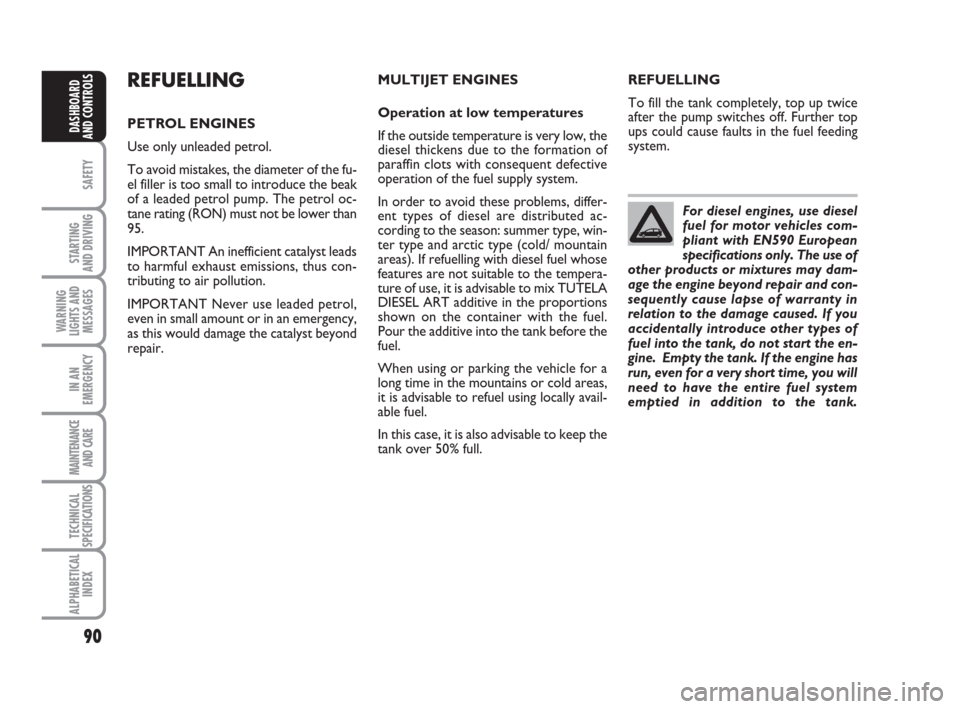
90
SAFETY
STARTING
AND DRIVING
WARNING
LIGHTS AND
MESSAGES
IN AN
EMERGENCY
MAINTENANCE
AND CARE
TECHNICAL
SPECIFICATIONS
ALPHABETICAL
INDEX
DASHBOARD
AND CONTROLS
For diesel engines, use diesel
fuel for motor vehicles com-
pliant with EN590 European
specifications only. The use of
other products or mixtures may dam-
age the engine beyond repair and con-
sequently cause lapse of warranty in
relation to the damage caused. If you
accidentally introduce other types of
fuel into the tank, do not start the en-
gine. Empty the tank. If the engine has
run, even for a very short time, you will
need to have the entire fuel system
emptied in addition to the tank.
REFUELLING
PETROL ENGINES
Use only unleaded petrol.
To avoid mistakes, the diameter of the fu-
el filler is too small to introduce the beak
of a leaded petrol pump. The petrol oc-
tane rating (RON) must not be lower than
95.
IMPORTANT An inefficient catalyst leads
to harmful exhaust emissions, thus con-
tributing to air pollution.
IMPORTANT Never use leaded petrol,
even in small amount or in an emergency,
as this would damage the catalyst beyond
repair.MULTIJET ENGINES
Operation at low temperatures
If the outside temperature is very low, the
diesel thickens due to the formation of
paraffin clots with consequent defective
operation of the fuel supply system.
In order to avoid these problems, differ-
ent types of diesel are distributed ac-
cording to the season: summer type, win-
ter type and arctic type (cold/ mountain
areas). If refuelling with diesel fuel whose
features are not suitable to the tempera-
ture of use, it is advisable to mix TUTELA
DIESEL ART additive in the proportions
shown on the container with the fuel.
Pour the additive into the tank before the
fuel.
When using or parking the vehicle for a
long time in the mountains or cold areas,
it is advisable to refuel using locally avail-
able fuel.
In this case, it is also advisable to keep the
tank over 50% full.REFUELLING
To fill the tank completely, top up twice
after the pump switches off. Further top
ups could cause faults in the fuel feeding
system.
Page 93 of 210
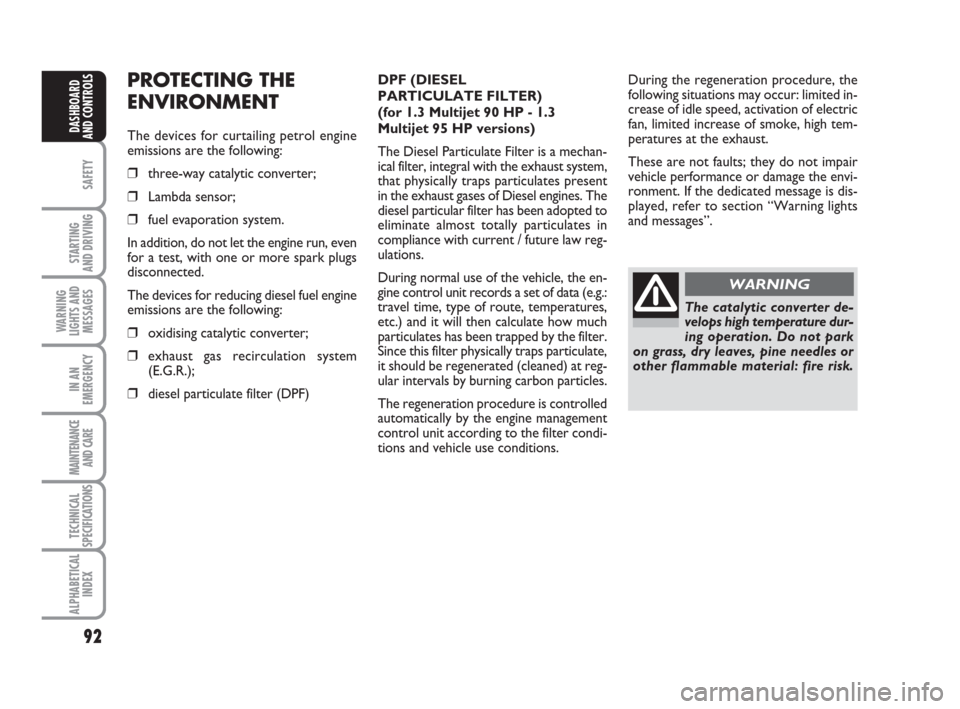
92
SAFETY
STARTING
AND DRIVING
WARNING
LIGHTS AND
MESSAGES
IN AN
EMERGENCY
MAINTENANCE
AND CARE
TECHNICAL
SPECIFICATIONS
ALPHABETICAL
INDEX
DASHBOARD
AND CONTROLS
PROTECTING THE
ENVIRONMENT
The devices for curtailing petrol engine
emissions are the following:
❒three-way catalytic converter;
❒Lambda sensor;
❒fuel evaporation system.
In addition, do not let the engine run, even
for a test, with one or more spark plugs
disconnected.
The devices for reducing diesel fuel engine
emissions are the following:
❒oxidising catalytic converter;
❒exhaust gas recirculation system
(E.G.R.);
❒diesel particulate filter (DPF)DPF (DIESEL
PARTICULATE FILTER)
(for 1.3 Multijet 90 HP - 1.3
Multijet 95 HP versions)
The Diesel Particulate Filter is a mechan-
ical filter, integral with the exhaust system,
that physically traps particulates present
in the exhaust gases of Diesel engines. The
diesel particular filter has been adopted to
eliminate almost totally particulates in
compliance with current / future law reg-
ulations.
During normal use of the vehicle, the en-
gine control unit records a set of data (e.g.:
travel time, type of route, temperatures,
etc.) and it will then calculate how much
particulates has been trapped by the filter.
Since this filter physically traps particulate,
it should be regenerated (cleaned) at reg-
ular intervals by burning carbon particles.
The regeneration procedure is controlled
automatically by the engine management
control unit according to the filter condi-
tions and vehicle use conditions.
The catalytic converter de-
velops high temperature dur-
ing operation. Do not park
on grass, dry leaves, pine needles or
other flammable material: fire risk.
WARNING
During the regeneration procedure, the
following situations may occur: limited in-
crease of idle speed, activation of electric
fan, limited increase of smoke, high tem-
peratures at the exhaust.
These are not faults; they do not impair
vehicle performance or damage the envi-
ronment. If the dedicated message is dis-
played, refer to section “Warning lights
and messages”.
Page 96 of 210
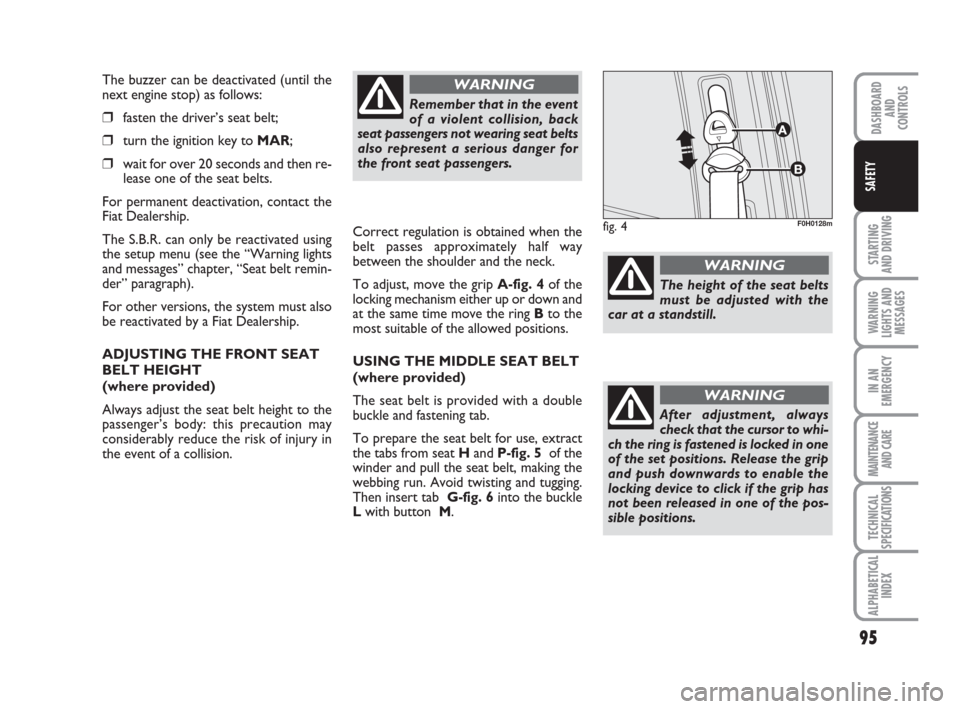
95
STARTING
AND DRIVING
WARNING
LIGHTS AND
MESSAGES
IN AN
EMERGENCY
MAINTENANCE
AND CARE
TECHNICAL
SPECIFICATIONS
ALPHABETICAL
INDEX
DASHBOARD
AND
CONTROLS
SAFETY
The buzzer can be deactivated (until the
next engine stop) as follows:
❒fasten the driver’s seat belt;
❒turn the ignition key to MAR;
❒wait for over 20 seconds and then re-
lease one of the seat belts.
For permanent deactivation, contact the
Fiat Dealership.
The S.B.R. can only be reactivated using
the setup menu (see the “Warning lights
and messages” chapter, “Seat belt remin-
der” paragraph).
For other versions, the system must also
be reactivated by a Fiat Dealership.
ADJUSTING THE FRONT SEAT
BELT HEIGHT
(where provided)
Always adjust the seat belt height to the
passenger’s body: this precaution may
considerably reduce the risk of injury in
the event of a collision. Correct regulation is obtained when the
belt passes approximately half way
between the shoulder and the neck.
To adjust, move the grip A-fig. 4of the
locking mechanism either up or down and
at the same time move the ring B to the
most suitable of the allowed positions.
USING THE MIDDLE SEAT BELT
(where provided)
The seat belt is provided with a double
buckle and fastening tab.
To prepare the seat belt for use, extract
the tabs from seat H and P-fig. 5of the
winder and pull the seat belt, making the
webbing run. Avoid twisting and tugging.
Then insert tab G-fig. 6into the buckle
Lwith button M.
Remember that in the event
of a violent collision, back
seat passengers not wearing seat belts
also represent a serious danger for
the front seat passengers.
WARNING
The height of the seat belts
must be adjusted with the
car at a standstill.
WARNING
After adjustment, always
check that the cursor to whi-
ch the ring is fastened is locked in one
of the set positions. Release the grip
and push downwards to enable the
locking device to click if the grip has
not been released in one of the pos-
sible positions.
WARNING
fig. 4F0H0128m
Page 111 of 210
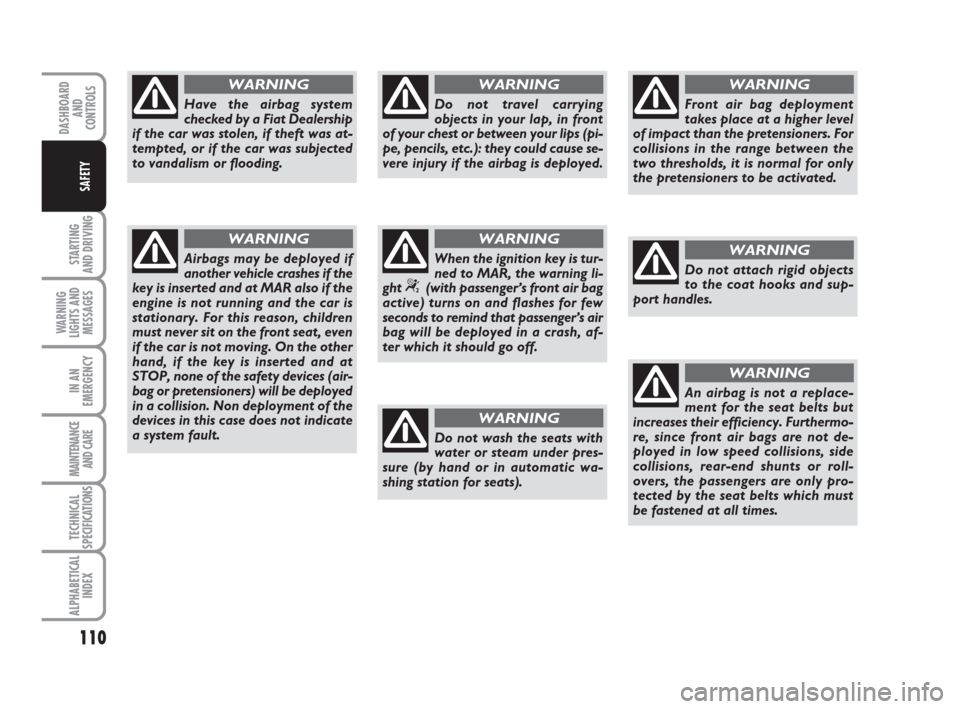
110
STARTING
AND DRIVING
WARNING
LIGHTS AND
MESSAGES
IN AN
EMERGENCY
MAINTENANCE
AND CARE
TECHNICAL
SPECIFICATIONS
ALPHABETICAL
INDEX
DASHBOARD
AND
CONTROLS
SAFETY
Have the airbag system
checked by a Fiat Dealership
if the car was stolen, if theft was at-
tempted, or if the car was subjected
to vandalism or flooding.
WARNING
Airbags may be deployed if
another vehicle crashes if the
key is inserted and at MAR also if the
engine is not running and the car is
stationary. For this reason, children
must never sit on the front seat, even
if the car is not moving. On the other
hand, if the key is inserted and at
STOP, none of the safety devices (air-
bag or pretensioners) will be deployed
in a collision. Non deployment of the
devices in this case does not indicate
a system fault.
WARNING
Do not travel carrying
objects in your lap, in front
of your chest or between your lips (pi-
pe, pencils, etc.): they could cause se-
vere injury if the airbag is deployed.
WARNING
When the ignition key is tur-
ned to MAR, the warning li-
ght
“(with passenger’s front air bag
active) turns on and flashes for few
seconds to remind that passenger’s air
bag will be deployed in a crash, af-
ter which it should go off.
WARNING
Do not wash the seats with
water or steam under pres-
sure (by hand or in automatic wa-
shing station for seats).
WARNING
Front air bag deployment
takes place at a higher level
of impact than the pretensioners. For
collisions in the range between the
two thresholds, it is normal for only
the pretensioners to be activated.
WARNING
Do not attach rigid objects
to the coat hooks and sup-
port handles.
WARNING
An airbag is not a replace-
ment for the seat belts but
increases their efficiency. Furthermo-
re, since front air bags are not de-
ployed in low speed collisions, side
collisions, rear-end shunts or roll-
overs, the passengers are only pro-
tected by the seat belts which must
be fastened at all times.
WARNING
Page 112 of 210
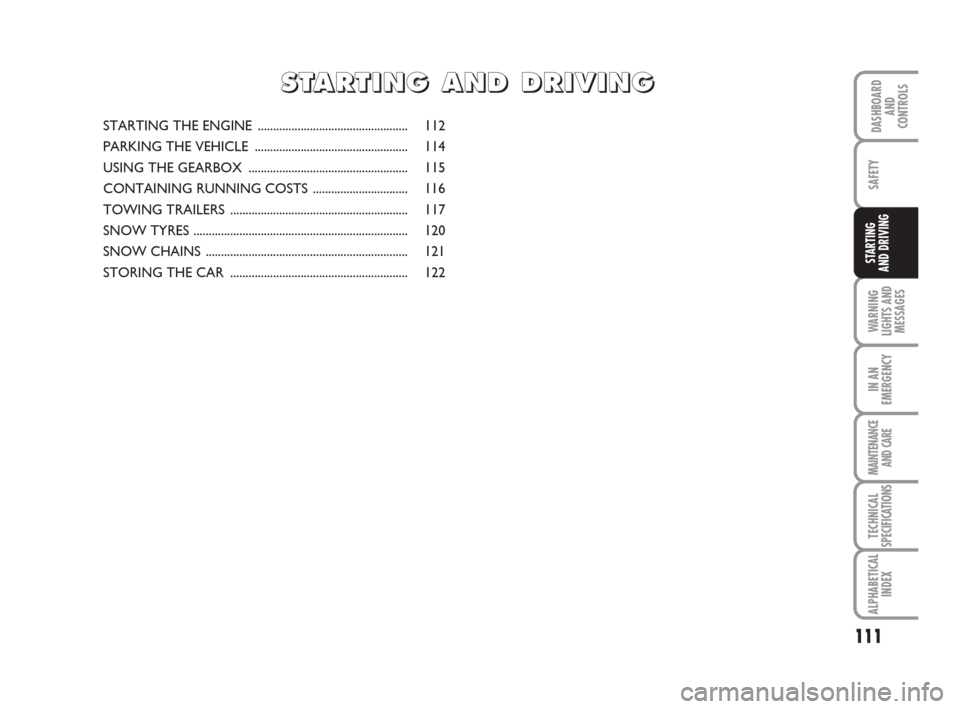
111
WARNING
LIGHTS AND
MESSAGES
IN AN
EMERGENCY
MAINTENANCE
AND CARE
TECHNICAL
SPECIFICATIONS
ALPHABETICAL
INDEX
DASHBOARD
AND
CONTROLS
SAFETY
STARTING
AND DRIVING
STARTING THE ENGINE ................................................. 112
PARKING THE VEHICLE .................................................. 114
USING THE GEARBOX .................................................... 115
CONTAINING RUNNING COSTS ............................... 116
TOWING TRAILERS .......................................................... 117
SNOW TYRES ...................................................................... 120
SNOW CHAINS .................................................................. 121
STORING THE CAR .......................................................... 122
S S
T T
A A
R R
T T
I I
N N
G G
A A
N N
D D
D D
R R
I I
V V
I I
N N
G G
Page 113 of 210
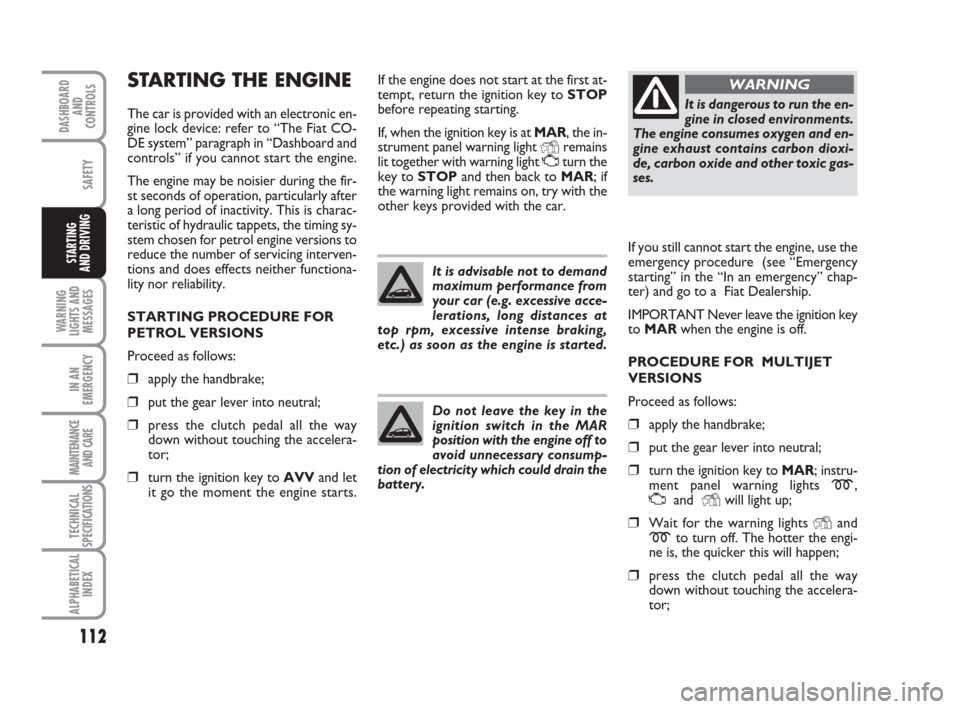
112
WARNING
LIGHTS AND
MESSAGES
IN AN
EMERGENCY
MAINTENANCE
AND CARE
TECHNICAL
SPECIFICATIONS
ALPHABETICAL
INDEX
DASHBOARD
AND
CONTROLS
SAFETY
STARTING
AND DRIVING
STARTING THE ENGINE
The car is provided with an electronic en-
gine lock device: refer to “The Fiat CO-
DE system” paragraph in “Dashboard and
controls” if you cannot start the engine.
The engine may be noisier during the fir-
st seconds of operation, particularly after
a long period of inactivity. This is charac-
teristic of hydraulic tappets, the timing sy-
stem chosen for petrol engine versions to
reduce the number of servicing interven-
tions and does effects neither functiona-
lity nor reliability.
STARTING PROCEDURE FOR
PETROL VERSIONS
Proceed as follows:
❒apply the handbrake;
❒put the gear lever into neutral;
❒press the clutch pedal all the way
down without touching the accelera-
tor;
❒turn the ignition key to AVVand let
it go the moment the engine starts.
It is dangerous to run the en-
gine in closed environments.
The engine consumes oxygen and en-
gine exhaust contains carbon dioxi-
de, carbon oxide and other toxic gas-
ses.
WARNINGIf the engine does not start at the first at-
tempt, return the ignition key to STOP
before repeating starting.
If, when the ignition key is at MAR, the in-
strument panel warning light
Yremains
lit together with warning light Uturn the
key to STOPand then back to MAR; if
the warning light remains on, try with the
other keys provided with the car.
If you still cannot start the engine, use the
emergency procedure (see “Emergency
starting” in the “In an emergency” chap-
ter) and go to a Fiat Dealership.
IMPORTANT Never leave the ignition key
to MARwhen the engine is off.
PROCEDURE FOR MULTIJET
VERSIONS
Proceed as follows:
❒apply the handbrake;
❒put the gear lever into neutral;
❒turn the ignition key to MAR; instru-
ment panel warning lights m,
Uand
Ywill light up;
❒Wait for the warning lights Yand
mto turn off. The hotter the engi-
ne is, the quicker this will happen;
❒press the clutch pedal all the way
down without touching the accelera-
tor; It is advisable not to demand
maximum performance from
your car (e.g. excessive acce-
lerations, long distances at
top rpm, excessive intense braking,
etc.) as soon as the engine is started.
Do not leave the key in the
ignition switch in the MAR
position with the engine off to
avoid unnecessary consump-
tion of electricity which could drain the
battery.
Page 114 of 210
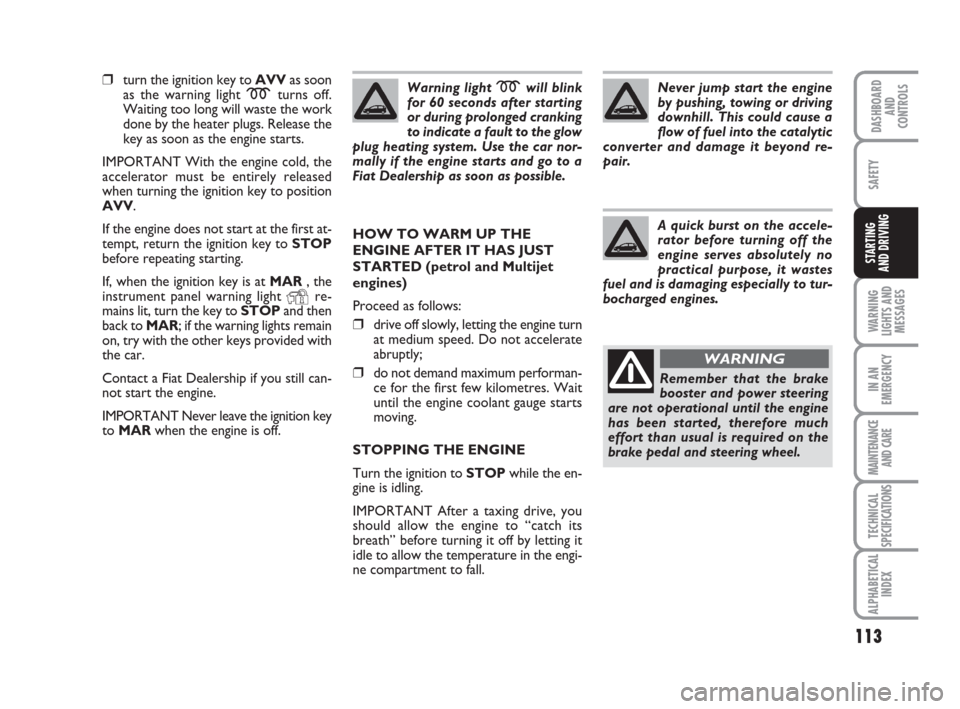
113
WARNING
LIGHTS AND
MESSAGES
IN AN
EMERGENCY
MAINTENANCE
AND CARE
TECHNICAL
SPECIFICATIONS
ALPHABETICAL
INDEX
DASHBOARD
AND
CONTROLS
SAFETY
STARTING
AND DRIVING
❒turn the ignition key to AVVas soon
as the warning light mturns off.
Waiting too long will waste the work
done by the heater plugs. Release the
key as soon as the engine starts.
IMPORTANT With the engine cold, the
accelerator must be entirely released
when turning the ignition key to position
AVV.
If the engine does not start at the first at-
tempt, return the ignition key to STOP
before repeating starting.
If, when the ignition key is at MAR, the
instrument panel warning light
Yre-
mains lit, turn the key to STOPand then
back to MAR; if the warning lights remain
on, try with the other keys provided with
the car.
Contact a Fiat Dealership if you still can-
not start the engine.
IMPORTANT Never leave the ignition key
to MARwhen the engine is off. Warning light
mwill blink
for 60 seconds after starting
or during prolonged cranking
to indicate a fault to the glow
plug heating system. Use the car nor-
mally if the engine starts and go to a
Fiat Dealership as soon as possible.
HOW TO WARM UP THE
ENGINE AFTER IT HAS JUST
STARTED (petrol and Multijet
engines)
Proceed as follows:
❒drive off slowly, letting the engine turn
at medium speed. Do not accelerate
abruptly;
❒do not demand maximum performan-
ce for the first few kilometres. Wait
until the engine coolant gauge starts
moving.
STOPPING THE ENGINE
Turn the ignition to STOPwhile the en-
gine is idling.
IMPORTANT After a taxing drive, you
should allow the engine to “catch its
breath” before turning it off by letting it
idle to allow the temperature in the engi-
ne compartment to fall. Never jump start the engine
by pushing, towing or driving
downhill. This could cause a
flow of fuel into the catalytic
converter and damage it beyond re-
pair.
A quick burst on the accele-
rator before turning off the
engine serves absolutely no
practical purpose, it wastes
fuel and is damaging especially to tur-
bocharged engines.
Remember that the brake
booster and power steering
are not operational until the engine
has been started, therefore much
effort than usual is required on the
brake pedal and steering wheel.
WARNING
Page 115 of 210
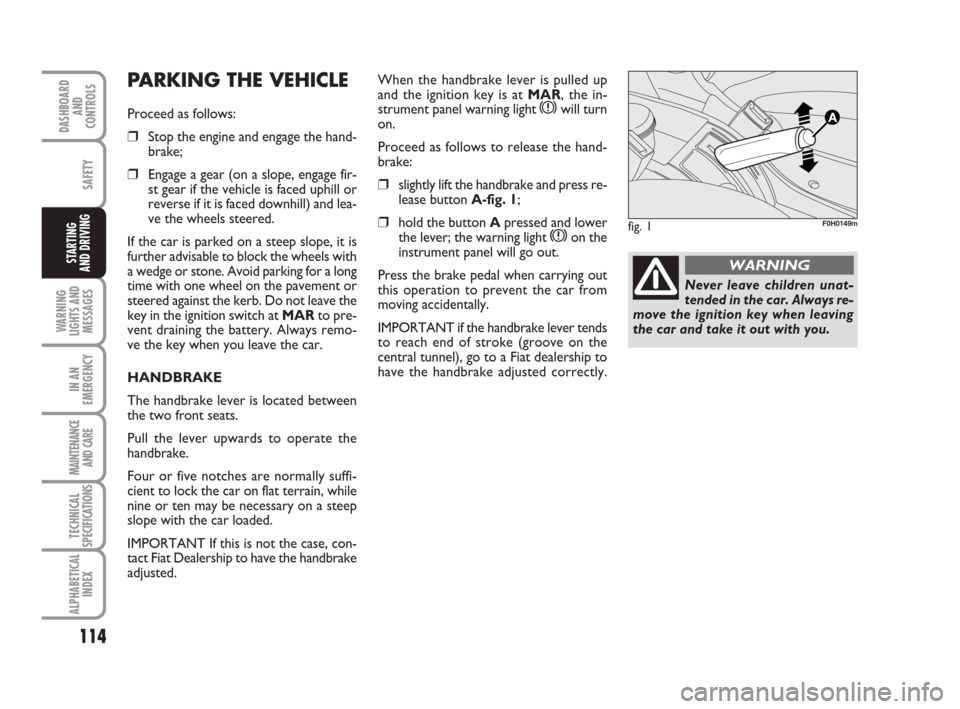
114
WARNING
LIGHTS AND
MESSAGES
IN AN
EMERGENCY
MAINTENANCE
AND CARE
TECHNICAL
SPECIFICATIONS
ALPHABETICAL
INDEX
DASHBOARD
AND
CONTROLS
SAFETY
STARTING
AND DRIVING
PARKING THE VEHICLE
Proceed as follows:
❒Stop the engine and engage the hand-
brake;
❒Engage a gear (on a slope, engage fir-
st gear if the vehicle is faced uphill or
reverse if it is faced downhill) and lea-
ve the wheels steered.
If the car is parked on a steep slope, it is
further advisable to block the wheels with
a wedge or stone. Avoid parking for a long
time with one wheel on the pavement or
steered against the kerb. Do not leave the
key in the ignition switch at MARto pre-
vent draining the battery. Always remo-
ve the key when you leave the car.
HANDBRAKE
The handbrake lever is located between
the two front seats.
Pull the lever upwards to operate the
handbrake.
Four or five notches are normally suffi-
cient to lock the car on flat terrain, while
nine or ten may be necessary on a steep
slope with the car loaded.
IMPORTANT If this is not the case, con-
tact Fiat Dealership to have the handbrake
adjusted.When the handbrake lever is pulled up
and the ignition key is at MAR, the in-
strument panel warning light
xwill turn
on.
Proceed as follows to release the hand-
brake:
❒slightly lift the handbrake and press re-
lease button A-fig. 1;
❒hold the button Apressed and lower
the lever; the warning light
xon the
instrument panel will go out.
Press the brake pedal when carrying out
this operation to prevent the car from
moving accidentally.
IMPORTANT if the handbrake lever tends
to reach end of stroke (groove on the
central tunnel), go to a Fiat dealership to
have the handbrake adjusted correctly.fig. 1F0H0149m
Never leave children unat-
tended in the car. Always re-
move the ignition key when leaving
the car and take it out with you.
WARNING
Page 116 of 210

115
WARNING
LIGHTS AND
MESSAGES
IN AN
EMERGENCY
MAINTENANCE
AND CARE
TECHNICAL
SPECIFICATIONS
ALPHABETICAL
INDEX
DASHBOARD
AND
CONTROLS
SAFETY
STARTING
AND DRIVING
USING THE GEARBOX
To engage the gears, press the clutch pe-
dal fully and shift the gear lever into one
of the required positions (the diagram is
shown on the knob).
IMPORTANT Reverse may only be enga-
ged when the car is at a standstill. With
the engine running, wait for at least 2 se-
conds with the clutch pedal fully pressed
before engaging reverse to prevent da-
mage to the gears and grating.
To engage 6th gear (where provided),
operate the lever by pressing it towards
the right in order to avoid engaging 4th
gear by mistake. The same applies to shif-
ting from 6th to 5th gear.
To engage reverse Rfrom idle position,
lift the sliding ring A-fig. 2-3under the
knob and at the same time shift the lever
rightwards and then backwards (petrol
versions only).
For Multijet versions, simply move the le-
ver rightwards and then backwards.
fig. 2F0H0150mfig. 3F0H0353m
Press the clutch pedal fully
to change gears correctly.
For this reason, there must be no ob-
stacles on the floor under the pedals:
ensure that rubber mats (if any) are
correctly positioned, not interfering
with the pedals.
WARNINGDo not drive with your hand
resting on the gear lever, be-
cause this pressure, even if li-
ght, over time can wear out
the gearbox inner components.